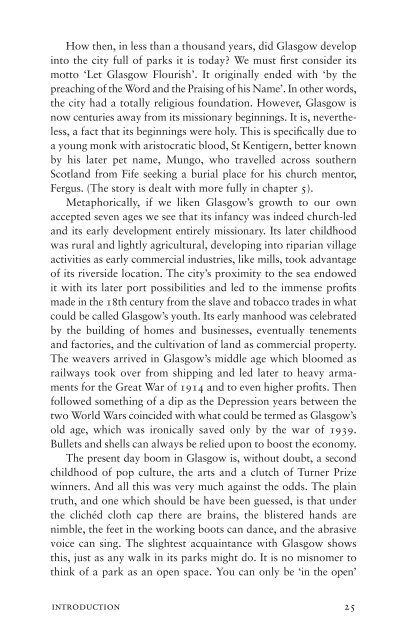A Walk in the Park by John Cairney sampler
A wander through twelve of Glasgow’s finest parks, and through the mind of a treasured Glasgow resident, John Cairney. Cairney’s exploration of his home city’s dear green places ranges from Tollcross Park in the east, to the Botanic Gardens, pride of the West End, and even right out to Hogganfield Loch in the city’s furthest reaches. Written with a deep love of the city, A Walk in the Park takes us on a journey into Glasgow’s past as well as through its outdoor spaces. Cairney traces his city’s history back a millennium to its founding by that great wanderer, St Mungo. Through the stories of its parks Glasgow comes to life, a post-industrial city with an unmatched individuality, a thriving cultural scene, and a lot to look forward to.
A wander through twelve of Glasgow’s finest parks, and through the mind of a treasured Glasgow resident, John Cairney. Cairney’s exploration of his home city’s dear green places ranges from Tollcross Park in the east, to the Botanic Gardens, pride of the West End, and even right out to Hogganfield Loch in the city’s furthest reaches.
Written with a deep love of the city, A Walk in the Park takes us on a journey into Glasgow’s past as well as through its outdoor spaces. Cairney traces his city’s history back a millennium to its founding by that great wanderer, St Mungo. Through the stories of its parks Glasgow comes to life, a post-industrial city with an unmatched individuality, a thriving cultural scene, and a lot to look forward to.
Create successful ePaper yourself
Turn your PDF publications into a flip-book with our unique Google optimized e-Paper software.
How <strong>the</strong>n, <strong>in</strong> less than a thousand years, did Glasgow develop<br />
<strong>in</strong>to <strong>the</strong> city full of parks it is today? We must first consider its<br />
motto ‘Let Glasgow Flourish’. It orig<strong>in</strong>ally ended with ‘<strong>by</strong> <strong>the</strong><br />
preach<strong>in</strong>g of <strong>the</strong> Word and <strong>the</strong> Prais<strong>in</strong>g of his Name’. In o<strong>the</strong>r words,<br />
<strong>the</strong> city had a totally religious foundation. However, Glasgow is<br />
now centuries away from its missionary beg<strong>in</strong>n<strong>in</strong>gs. It is, never<strong>the</strong>less,<br />
a fact that its beg<strong>in</strong>n<strong>in</strong>gs were holy. This is specifically due to<br />
a young monk with aristocratic blood, St Kentigern, better known<br />
<strong>by</strong> his later pet name, Mungo, who travelled across sou<strong>the</strong>rn<br />
Scotland from Fife seek<strong>in</strong>g a burial place for his church mentor,<br />
Fergus. (The story is dealt with more fully <strong>in</strong> chapter 5).<br />
Metaphorically, if we liken Glasgow’s growth to our own<br />
accepted seven ages we see that its <strong>in</strong>fancy was <strong>in</strong>deed church-led<br />
and its early development entirely missionary. Its later child hood<br />
was rural and lightly agricultural, develop<strong>in</strong>g <strong>in</strong>to riparian village<br />
activities as early commercial <strong>in</strong>dustries, like mills, took advantage<br />
of its riverside location. The city’s proximity to <strong>the</strong> sea endowed<br />
it with its later port possibilities and led to <strong>the</strong> immense profits<br />
made <strong>in</strong> <strong>the</strong> 18th century from <strong>the</strong> slave and tobacco trades <strong>in</strong> what<br />
could be called Glasgow’s youth. Its early manhood was celebrated<br />
<strong>by</strong> <strong>the</strong> build<strong>in</strong>g of homes and bus<strong>in</strong>esses, eventually tenements<br />
and factories, and <strong>the</strong> cultivation of land as commercial property.<br />
The weavers arrived <strong>in</strong> Glasgow’s middle age which bloomed as<br />
railways took over from shipp<strong>in</strong>g and led later to heavy armaments<br />
for <strong>the</strong> Great War of 1914 and to even higher profits. Then<br />
followed someth<strong>in</strong>g of a dip as <strong>the</strong> Depression years between <strong>the</strong><br />
two World Wars co<strong>in</strong>cided with what could be termed as Glasgow’s<br />
old age, which was ironically saved only <strong>by</strong> <strong>the</strong> war of 1939.<br />
Bullets and shells can always be relied upon to boost <strong>the</strong> economy.<br />
The present day boom <strong>in</strong> Glasgow is, without doubt, a second<br />
childhood of pop culture, <strong>the</strong> arts and a clutch of Turner Prize<br />
w<strong>in</strong>ners. And all this was very much aga<strong>in</strong>st <strong>the</strong> odds. The pla<strong>in</strong><br />
truth, and one which should be have been guessed, is that under<br />
<strong>the</strong> clichéd cloth cap <strong>the</strong>re are bra<strong>in</strong>s, <strong>the</strong> blistered hands are<br />
nimble, <strong>the</strong> feet <strong>in</strong> <strong>the</strong> work<strong>in</strong>g boots can dance, and <strong>the</strong> abrasive<br />
voice can s<strong>in</strong>g. The slightest acqua<strong>in</strong>tance with Glasgow shows<br />
this, just as any walk <strong>in</strong> its parks might do. It is no misnomer to<br />
th<strong>in</strong>k of a park as an open space. You can only be ‘<strong>in</strong> <strong>the</strong> open’<br />
<strong>in</strong>troduction 25


















